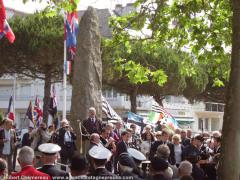Remembering the wreck of HMS «Lancastria» on June 17th, 1940 in Saint-Nazaire




The largest British maritime disaster took place just off the Loire estuary on June 17th, 1940 when the passenger ship [[[RMS Lancastria]]] – hastily arrived from Great Britain – to sail back there the large number of British and soldiers of other nationalities (1), as well as civilians she had boarded, was bombed by 4 German Junkers.
This disaster, which killed, as it is said, 2,500 to more than 5,000 persons, including 1,728 of them found (2) and identified, will be commemorated in Saint-Nazaire this Friday, June 17th, at 11 am in the presence of many British including members of the families of the missings, and Bretons of the CREDIB. The ceremony will take place near the monument erected in 1988, next to the [[[St Nazaire Raid]]] monument.
From the Lancastria Association of Scotland web site : (voir le site)
On the sea front in the harbour town of Saint-Nazaire, the official Lancastria monument can be found. Inscribed in both French and English it reads:
« Opposite this place lies the wreck of the troopship Lancastria sunk by enemy action on 17 June 1940 whilst embarking British troops and civilians during the evacuation of France. To the glory of God, in proud memory of more than 4,000 who died and in commemoration of the people of Saint-Nazaire and surrounding districts who saved many lives, tended wounded and gave a Christian burial to victims. We have not forgotten. HMT “Lancastria” Association, 17 June, 1988. »
(voir notre article) et (voir le site) of CREDIB Sant-Nazer for a report of the 2010 commemoration, and (voir le site) of English wikipedia with the whole history.
(1) Waiting at Saint-Nazaire were a large number of British Army support and logistic units, RAF personnel, Belgian, Czech and Polish troops, as well as British civilians. From the Wikipedia [[[Operation Ariel]]] site : evacuation of Allied forces from ports in western France, June 15th to June 25th, 1940.
(2) On the following days, many were found along the nearby coasts. They were buried, identified or not, in cemeteries of the area, as in La Baule, Pornic or still Les Moutiers-en-Retz... (See photo 3).
Hubert Chémereau, English by Maryvonne Cadiou, from (voir notre article)